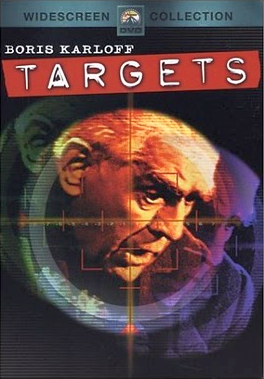“Targets” is one of those movies I’ve been curious about for decades but never gotten round to watching. Until last week, when I got round to watching it…
“Targets” is noteworthy for two reasons. First, it was Peter Bogdanovich’s first film as director and, second, it was one of Boris Karloff’s last films – not to mention his last good film. The whole thing came about when Roger Corman suggested to Bogdanovich that he might want to direct a movie using the two days’ work that Karloff owed him as well as bits of footage from “The Terror,” a movie renowned for its sheer awfulness. Someone else had already suggested to Bogdanovich that a movie about Charles Whitman might be a good idea, so Bogdanovich blended this with his own conceit of Karloff playing an old horror movie star, and so was born “Targets,” an excellent example of how mere expediency can lead to quality film-making when the people involved know what they are doing.
Written by Bogdanovich, Polly Platt and an uncredited Samuel Fuller, the movie offers a novel idea – a juxtaposition of fake, old-fashioned movie horror and the kind of real-life horror that, in the late 1960s, was just starting to make itself felt. Karloff plays Byron Orlok, a man who is, in most respects, Karloff himself, and who ends up at a drive-in showing of “The Terror” at the same time that spree killer Bobby Thompson chooses it as the setting for his last stand. At this point in the film, Thompson has already done the Whitman by killing his wife and mother and several motorists and now, not being able to find a convenient University tower, has chosen to snipe at movie-goers from a hole in the drive-in’s screen. While the idea is interesting and ahead of its time in the blending of fact and fiction, and makes for a solid and entertaining piece of work, it is hard to see what is to be learned from it. That real life violence is scarier than screen violence? Sorry, Pete, but we already knew that. On the other hand, perhaps I have seen too much real-life violence, not to mention a lot of true crime documentaries, and therefore don’t need something so obvious pointed out to me. Perhaps to middle class Americans of the late sixties the message may have come across as a surprising one — different time, different place, different perspective.
If there is one serious flaw in this otherwise worthy piece of celluloid it is the acting. Bogdanovich himself plays a director friend of Karloff’s and just barely gets the job done – even Bogdanovich admits that for many years after making this film he was reluctant to cast himself in his own movies. Karloff, second only to Vincent Price in my personal list of Great Horror Stars of Yesteryear, comes across as, I am sorry to say, rather stiff and un-natural. Whether this is because, like his character, he has lost the ability to play straight or because he was working on the film for only two days and presumably had little rehearsal time can only be guessed at. Either way, it’s a lackluster performance. Appropriately enough, Karloff’s best moment comes when he tells a brief story about a man who tries to flee death only to ride straight into its arms – vintage Karloff, the kind of thing he was so good at for so many decades. But the only actor I found truly notable was Tim O’Kelly, who played the Whitman figure. This could be due to O’Kelly’s talent or due to the fact that he is playing a fairly un-emotional character. It’s hard to tell given that I haven’t seen him in anything else but, nonetheless, his performance and his wholesome, boy-next-door looks make for a striking contrast to the obviously demented weirdoes Karloff so often played, and this in turn makes a point about real-life horror — namely that the psychos aren’t easily spotted until the bullets start flying.
Despite the flawed acting, the script and the direction carry the movie through, with the kill scenes being especially impressive – cold, detached, and clinical. It all comes across as un-sensationalized and, precisely for that reason, realistic. Watching these kill scenes is like crouching at the window looking out at a real-life shooting – no dramatic music, no fast edits, no swirling cameras, no bodies flying several feet through the air. Victims fall in a heap where they are shot, uttering only the smallest of sounds, just as happens in real life if cops and soldiers are to be believed.
The ending is a bit flat, with the Whitman guy turning to jelly when confronted by a cane-wielding Karloff, who slaps him down and leaves him cowering in a corner. I suppose his seeing Karloff both in life and on the screen seems to have freaked him out, but this isn’t exactly realistic and rather contradicts the idea that the old movies aren’t’ scary anymore! Not exactly a believable ending, but hey, it was a rush job done on 125 thousand and it’s still more enjoyable than multimillion dollar flash trash like “Thor : The Dark World,” which I tried to watch over the weekend and which had me retching within 20 minutes. I guess it all goes to show that it isn’t the budget, it isn’t the fancy FX, it’s the talent that matters and when the writers and the director are artists of quality you get something that is, if not a classic, then a movie well worth watching.
